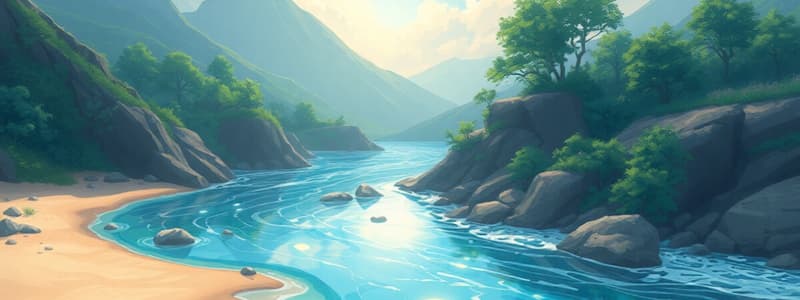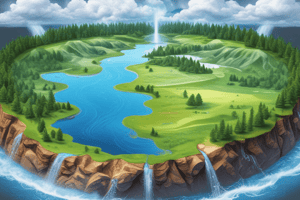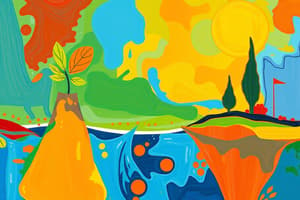Podcast
Questions and Answers
Match the percentage of Earth's water with its type:
Match the percentage of Earth's water with its type:
97% = Salt water 2% = Frozen fresh water 1% = Available fresh water 0% = Water unavailable for use
Match the terms of the water cycle with their definitions:
Match the terms of the water cycle with their definitions:
Evaporation = Liquid to gas Condensation = Gas to liquid Precipitation = Water falling to Earth Run-off = Water flowing across the surface
Match the components of Earth with their definitions:
Match the components of Earth with their definitions:
Lithosphere = Solid rock of Earth's crust Atmosphere = Environment surrounding the planet Hydrosphere = All the water on Earth Biosphere = All living organisms
Match the differences between ocean water and fresh water:
Match the differences between ocean water and fresh water:
Match the factors affecting marine life with their characteristics:
Match the factors affecting marine life with their characteristics:
Match the water cycle stages with their examples:
Match the water cycle stages with their examples:
Match the conditions that are harmful to aquatic life:
Match the conditions that are harmful to aquatic life:
Match the examples of freshwater resources with their characteristics:
Match the examples of freshwater resources with their characteristics:
Match the following sources of fresh water with their descriptions:
Match the following sources of fresh water with their descriptions:
Match the following terms related to glaciers with their definitions:
Match the following terms related to glaciers with their definitions:
Match the following processes with their effects on marine life:
Match the following processes with their effects on marine life:
Match the following components of the fresh water cycle with their characteristics:
Match the following components of the fresh water cycle with their characteristics:
Match the following terms with their associated concepts:
Match the following terms with their associated concepts:
Match the following effects of global warming with their outcomes:
Match the following effects of global warming with their outcomes:
Match the following types of water bodies with their environmental roles:
Match the following types of water bodies with their environmental roles:
Match the following features of upwelling with their significance:
Match the following features of upwelling with their significance:
Flashcards
Salinity
Salinity
The amount of dissolved salt in a specific volume of water. Ocean water has a high salinity (around 35g/L), while freshwater has almost no salt (around 0g/L).
Density of water
Density of water
The amount of mass of a substance in a certain unit of volume. Ocean water is denser than freshwater because of the dissolved salts.
Freezing Point of water
Freezing Point of water
The temperature at which a liquid freezes. Ocean water freezes at a slightly lower temperature than freshwater due to the dissolved salts.
Run-off
Run-off
Signup and view all the flashcards
Groundwater
Groundwater
Signup and view all the flashcards
Evaporation
Evaporation
Signup and view all the flashcards
Condensation
Condensation
Signup and view all the flashcards
Precipitation
Precipitation
Signup and view all the flashcards
What is upwelling?
What is upwelling?
Signup and view all the flashcards
What is groundwater?
What is groundwater?
Signup and view all the flashcards
Define glacier.
Define glacier.
Signup and view all the flashcards
What is an iceberg?
What is an iceberg?
Signup and view all the flashcards
What is an ice age?
What is an ice age?
Signup and view all the flashcards
What is a drainage basin?
What is a drainage basin?
Signup and view all the flashcards
What is a divide?
What is a divide?
Signup and view all the flashcards
What is glacier recession?
What is glacier recession?
Signup and view all the flashcards
Study Notes
Earth's Water Distribution
- 97% of Earth's water is saltwater.
- 2% of Earth's water is frozen (glaciers, ice caps, icebergs).
- 1% of Earth's water is available for use (drinking, etc.).
The Water Cycle
- Lithosphere: Earth's solid rock crust.
- Atmosphere: The layer of gases surrounding Earth.
- Hydrosphere: All the water on Earth.
- Water moves from Earth to the atmosphere and back to Earth in a continuous cycle.
Water Cycle Processes
- Evaporation: Liquid water changes to a gas (water vapor).
- Condensation: Water vapor changes to a liquid (water droplets).
- Precipitation: Water falls to Earth as rain, snow, sleet, or hail.
- Runoff: Water that flows over the land surface.
- Groundwater: Water that seeps into the ground.
Ocean Water vs. Fresh Water
- Salinity: The amount of dissolved salt in water (Ocean - about 35 g/L, Fresh - about 0 g/L).
- Density: The amount of mass in a certain volume (Ocean - 1.027 g/L, Fresh - 1.000 g/L).
- Freezing Point: The temperature at which a liquid changes to a solid (Ocean - -1.9°C, Fresh - 0°C).
Factors Affecting Aquatic Life
- Temperature: Organisms have tolerance ranges.
- Dissolved Oxygen: Needs to be at least 5 mg/L.
- Phosphates: Levels less than 10 micrograms/L are good for aquatic plants (too much can be harmful).
- Acidity: Should be between 5 and 8.5.
- Turbidity: Water cloudiness due to pollution or solids.
- Pollution: Is harmful to organisms.
- Upwelling: Deep, cool water rises to the surface bringing nutrients.
Sources of Fresh Water
- Lakes, Ponds, Wetlands, Streams, and Rivers: Runoff water collects or flows.
- Groundwater: Water seeps into the ground and collects in pores and cracks in rock.
- Glaciers: Large bodies of ice on land.
- Icebergs: Chunks of ice that break off glaciers and float in the ocean.
- Ice Ages: Periods in Earth's history where glaciers cover much of the land.
- Drainage Basins (Watersheds): Areas of land that drain into a body of water (river, lake, ocean, etc.).
Studying That Suits You
Use AI to generate personalized quizzes and flashcards to suit your learning preferences.




